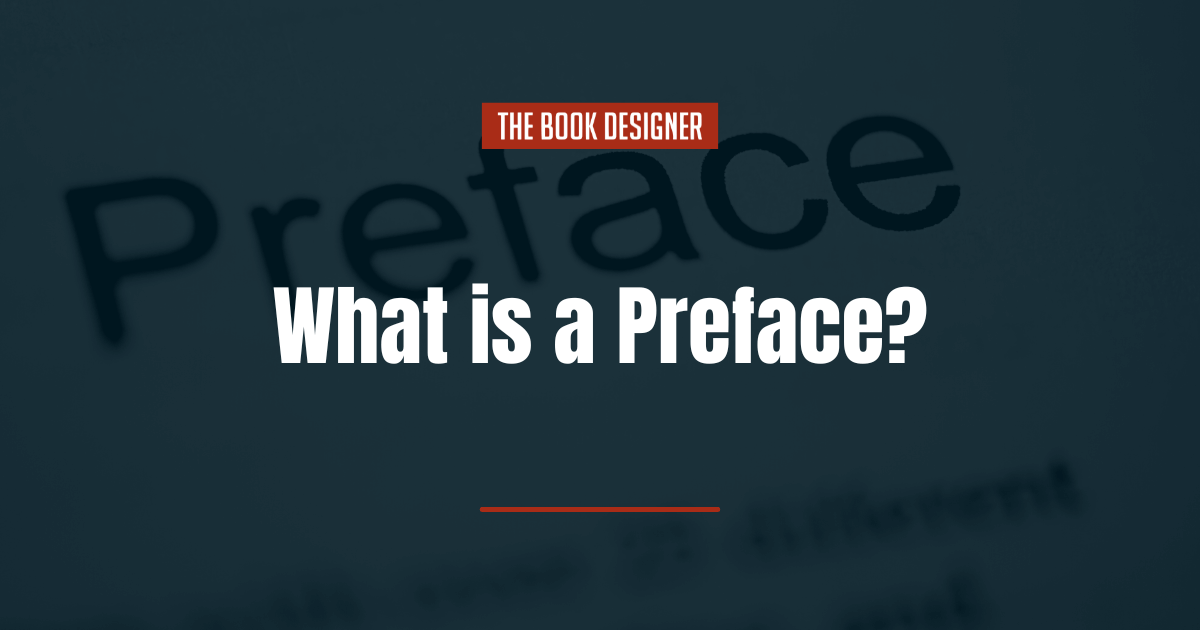Some basic parts of a book are obvious. You likely know what a table of contents or dedication is. But what is an acknowledgement and what does it include? What is a preface? And how is that different than an introduction? It might not be glamorous or exciting, but it’s essential to understand these elements and make sure your book contains everything a reader expects.
One of these plain but essential basic elements is the preface of a book. What is a preface, what should it contain, and what are some other similar book elements that you might confuse for prefaces?
This quick guide covers everything you need to know about prefaces to give you the confidence to create a complete book with all the parts in place.

Table of Contents
What is a Preface?
A preface is a brief contextualization of a book, usually included as part of its front matter.
Prefaces are most often found in nonfiction or academic books, while other book types use similar but differently-named sections (such as a foreword).
A typical preface is written from the perspective of the author and offers the reason why the author wrote the book, the context that led to it, and perhaps even the message the reader should take away.
Is a Preface the Same Thing as a Prologue?
No, a preface and prologue are not the same, as a prologue is most often found at the start of works of fiction, while a preface is associated with works of academia and nonfiction.
Often, a prologue will be written as if it was penned by one of the fictional characters found in the book, while a preface is clearly written by the author in their own voice and style.
See this article for more information on what a foreword is and how it is different.
What is a Preface’s Purpose?
As prefaces are typically found in nonfiction and academic books, they are used to whet the intellectual appetite of the reader and introduce them to the journey that culminated in the book they are now reading.
Ideally, a reader will finish a preface feeling as if they have insight into the deeper purpose for the book they are about to begin, the mindstate of its creator, how it relates to other works, and what they might end up discovering after getting to the final page.

Are a Preface and an Acknowledgment the Same?
Book prefaces and acknowledgments have different purposes and are sometimes found in different sections of books.
So what are the differences between the two?
A book’s preface is intended for the reader. It should offer them context and encourage them to read on and discover what the full book contains.
A book’s acknowledgment section, on the other hand, is intended for anyone the author is grateful for and wishes to formally thank in the book. This is often a mix of people professionally connected to the author and the book as well as people in their personal life.
For example, you’ll often find editors and proofreaders receive an acknowledgment, as do friends, spouses, and family members.
The final difference between prefaces and acknowledgments is where they are situated in the book. A preface is typically found right at the start, as part of the front matter, while an acknowledgments section can be in the front matter or the back matter, depending on the book.
What is Included in a Preface?
Hopefully, it’s now clear what a preface is, what it isn’t, and where it should be located in your book.
But what should you put in your preface? What is and isn’t suitable for inclusion?
Here are some quick takeaway tips for what you should make sure your preface contains:
- Who you are. This is especially important if you aren’t yet established as a major name within your field. It’s a great idea to say something about your credentials and your background so that your reader knows they are in the right hands.
- Why you wrote the book. What was your main purpose for writing? Your preface could cover the context that led you to write this book in particular, such as noticing a gap in the information out there, or feeling that the content hadn’t been covered from the right angle or by someone with your unique perspective. Your reader might well be considering a number of books on the same topic, so give them every reason to realize yours is the best fit for their interests.
- How your main book idea came about. It’s often fascinating to have a little bit of insight into the Eureka moment where you initially had an idea for a particular book. What were you doing at the time? Did you see or read something that gave you a brainwave? This type of detail is fascinating for readers to understand.
- Anything intriguing about the book creation process. Beyond giving insight into the initial spark of an idea you had, can you share something intriguing about the process of writing the full book? For example, did you carry out any unusual or interesting research, interview noteworthy figures within a particular field, or visit noteworthy locations while putting the book together?
What Tone Should I Use in My Preface?
A final thought is to carefully consider the tone of your preface. What type of book does it accompany? What will the reader be expecting? What is the most suitable tone based on those two factors?
For example, a nonfiction book examining criminal cold cases might have an exciting but serious tone, an academic history book might come across a little drier and more formal, while a book about dealing with grief should sound compassionate and caring.
If you’re not sure about the right tone for your preface, there are a couple of things you can do to figure it out:
Read the prefaces of similar books. What do they cover? What are their tones like? What are the aspects of these prefaces you could see working well for your own book?
Write several samples. There’s no harm in writing several prefaces and getting feedback on each of them. Try to include different content and use different tones. Then, ask fans of the genre you are writing in for their honest feedback. Which prefaces did they like or dislike? Why did they feel that way about them? Incorporate this feedback into writing a final version of your preface.
Although it’s easy to underestimate the importance of a preface, they can heavily influence a reader’s purchasing decision!
It’s likely that someone considering buying your book is probably browsing several on the same topic. A well-written preface could be all the difference in ensuring yours is the one they end up buying.

If you’d like to have help with your formatting, book design, and publishing, check out our Publishing Package.



